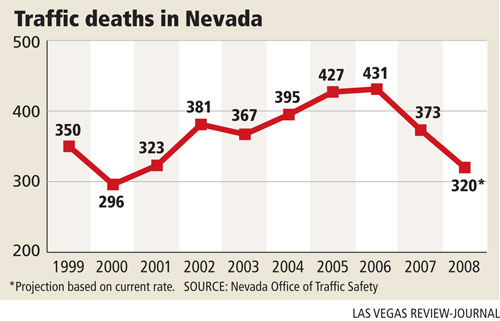Fatalities on roads declining
CARSON CITY -- Believe it or not, there was a silver lining to paying $4 a gallon for gasoline last summer: People cut down on unnecessary driving and far fewer of them died in accidents on Nevada's highways and roads.
The Nevada Office of Traffic Safety expects that 320 people will die in traffic accidents in the state this year if the current rate continues through the rest of the year. As of Thursday, 311 had been killed.
If the trend continues, there will be 53 fewer fatalities than last year and 111 fewer than in 2006.
The fatal accident rate has remained down even though people may have started to drive more with gasoline prices falling into the $1.70 per gallon range, the lowest in five years.
Only one traffic fatality was recorded in Clark County during the week that included Thanksgiving, a time when gasoline prices were relatively low, said John Johansen, impaired-driving coordinator for the state Office of Traffic Safety.
He cannot recall that happening before.
"We are thrilled with what we are seeing," Johansen said. "People have changed how they are driving. It is unbelievable we will have more than 100 less people dying than two years ago."
Maj. Tony Almaraz of the Nevada Highway Patrol attributes the decline in highway fatalities to a combination of factors -- less driving due to high gasoline prices, fewer tourists, greater seat belt use, more enforcement of traffic laws and better-built cars.
Since he became a police officer 21 years ago, Almaraz said he has seen dramatic improvements in the safety features and construction of motor vehicles.
"I have seen people in horrible, T-bone collisions who were not seriously injured," he said. "Cars are being built better. They have airbags, some have side airbags. Airbags are critical components."
The numbers match what is occurring nationally. Traffic deaths were down 10 percent in 2008 through October, according to the National Highway Traffic Safety Administration.
The agency attributed the decline in deaths to a drop in the number of miles Americans have been driving because of high gasoline prices. It found Americans were driving less beginning late in 2007 every month through October 2008.
Nevada's decline in deaths exceeds the national trend.
Johansen is disturbed, however, that the number of motorcycle and pedestrian deaths is not declining.
About 50 motorcycle riders and a similar number of pedestrians have been dying in Nevada each year for at least three years.
Nearly half of the pedestrians killed in accidents with motor vehicles had been drinking, some excessively.
Though high gasoline prices played a role, Johansen said Nevada highway deaths are down because most people wear seat belts.
Seat belt use in the state has exceeded 90 percent since 2005. Fewer than 75 percent of Nevadans wore seat belts in 2001.
He said more than 92 percent of Nevadans now wear seat belts.
Although some people still complain about wearing seat belts, they have decided they prefer wearing them to receiving a ticket, Johansen said.
Nevada has a "secondary" seat belt law. People cannot be cited for not wearing their belts unless the officer also charges them with another type of driving offense.
Among states with secondary laws, Nevada ranks first in seat belt use.
Johansen also believes greater enforcement by police has contributed to the decline in fatalities.
Every month, somewhere in Nevada police are conducting checks to look for impaired drivers or talking about wearing seat belts to drivers and community organizations, he said.
Besides continuing to wear seat belts and not driving after drinking, Almaraz and Johansen have another safety tip for drivers this holiday season: Keep your speed down.
Contact Capital Bureau Chief Ed Vogel at evogel@reviewjournal.com or 775-687-3901.

















